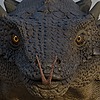HOME | DD
 VikasRao — Triassic horned fighter or show-off?
by-nc-sa
VikasRao — Triassic horned fighter or show-off?
by-nc-sa

#3dart #animals #blender3d #cgi #creaturedesign #digitalart #dinosaur #dinosaurs #ecology #evolution #india #mesozoic #nature #palaeoart #palaeontology #paleoart #paleontology #prehistory #sciart #scientificillustration #triassic #wildlife #archosauromorpha #blendercycles #shringasaurus #allokotosauria #triassicpaleoart #triassicreptile #paleothemeweek #triassicperiodweek
Published: 2021-07-31 14:49:38 +0000 UTC; Views: 23661; Favourites: 256; Downloads: 0
Redirect to original
Description
Cutting it a bit close but last entry for #triassicweek
...........................................................................................................................................................................................................................................................................................................
Madhya Pradesh, India, 245 mya
A pair of female Shringasaurus indicus browse on conifer leaves while a third basks on a rock. A large male in breeding colours meanwhile struts around hoping to catch their attention.
Shringasaurus (meaning horned lizard) was, despite the name, not a lizard but an allokotosaur, a clade of archosauromorph reptiles that lived in the Middle and Late Triassic and included a number of rather odd-looking taxa. They weren't particularly closely related to the Archosauria (crocodylians, dinosaurs, pterosaurs & allies), but were still more closely related to them than to any other reptilian lineage. Within this clade, Shringasaurus belonged to the Azendohsauridae, a family of medium to large herbivorous reptiles that appeared to have been on the same evolutionary trajectory as the sauropod dinosaurs (which had yet to appear). At 4m in length, Shringasaurus is the largest known azendohsaurid, and as of yet the only known species that possessed a pair of short cranial horns.
It would've shared its ecosystem (what would become the Denwa Formation), with several other herbivores, including medium-large dicynodonts as well as a large rhynchosaur, another archosauromorph reptile. The environment in which it lived is thought to have been a semi-arid, seasonal floodplain, not too dissimilar to the region today. While all the 3 taxa were herbivores, their differing morphologies indicate a good degree of niche partitioning: the short, lizard-like rhynchosaurs would've fed primarily upon roots, tubers & other tough, low-lying vegetation; the dicynodonts would've been low-browsers feeding on ferns and club mosses, while the long-necked Shringasaurus was likely a proficient high-browser, much like the later sauropods, feeding on higher vegetation.
Fossils of Shringasaurus show the horns developed with age, with adults having larger horns than juveniles. Even more interestingly, some fully-grown adults lack horns, while some juveniles have very small horns. This implies that Shringasaurus was probably sexually dimorphic, with only adult males having fully-formed horns. Such significant sexual dimorphism is rare in archosauromorphs and reptiles in general, but relatively common in mammals, particularly ungulates, several species of which have similar horns (this also means that other azendohsaurids may have possessed similar sexually dimorphic horns, but we have yet to find fossils of the hornless sex). The best-known modern reptile to possess such sexual dimorphism is the Jackson's chameleon (Trioceros jacksonii). It's still unclear if males would've actually engaged in combat like modern ungulates, but if Jackson's chameleons are any indication, it may have been a very rare occurrence.
One explanation as to why male combat is especially prevalent in mammals as compared to birds & non-avian reptiles is that most mammals are dichromats, i.e., they can only see blues & greens. By comparison, most reptiles (including birds) are tetrachromats, and thus possess colour vision far superior to our own, which is understandable given that many of them are diurnal, visually oriented animals. This means that instead of having to frequently engage in physical fights for dominance or feats of strength as a show of fitness, showing off bright display colours and/or structures usually suffice (though there are exceptions). This is the reason why many male reptiles (including birds) have crests, dewlaps and/or bright breeding colours. Among mammals, mandrills (Mandrillus sphinx), which as with humans have trichromatic colour vision, show similar sexual dimorphism as many birds & non-avian reptiles.
Therefore, it's more likely that male Shringasaurus would've spent more time displaying to females by showing off bright breeding colours and warding off rival males with aggressive posturing and only coming to blows on very rare occasions like most modern reptiles. Any physical fights would likely have been in short bursts rather than a drawn-out battle as in most modern mammals.
Regardless of whether Shringasaurus clashed like some prehistoric reptilian bison (or giraffe considering its long neck) or showed off its colours and ornate features like a cow-sized iguana, the very fact that it shows such sexual dimorphism would imply that ecological conditions in the Triassic were similar enough to those of modern times that they promoted the evolution of very similar traits. This of course would contrast strongly to ecological conditions of the Late Permian, which were more similar to those of earlier Palaeozoic periods than to the Mesozoic, despite being chronologically closer to the latter and the fact that the overall geography of the planet was fairly constant throughout the Permian and Triassic, with Pangaea dominating both time periods. This further shows just how significant the Great Dying (Permian-Triassic extinction) was in altering global ecosystems. While the world would've looked nearly the same, it's clear that the difference in biodiversity between the Permian and Triassic periods was as clear as night & day.





















